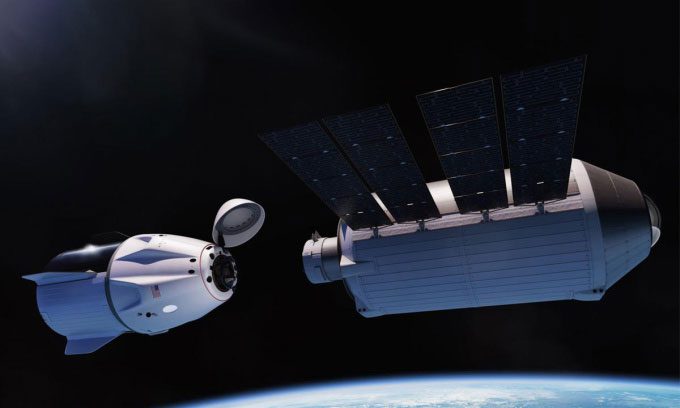The laboratory of the Haven-1 space station is designed with 10 large cargo modules, each the size of a microwave oven, with a maximum capacity of 30 kg, set to launch in 2025.
Vast, a commercial space station company based in the United States, is developing a private microgravity laboratory as part of the Haven-1 space station initiative, reported Interesting Engineering on August 2. This represents a significant advancement in the field of space research and production.

Simulation of SpaceX’s Dragon spacecraft flying to Haven-1 space station. (Image: Vast).
The Haven-1 Laboratory is designed with 10 cargo modules, similar in size to the “mid-lockers” on the International Space Station (ISS). These cargo modules are approximately microwave-sized, capable of carrying a maximum payload of 30 kg, providing 100 W of continuous power, and featuring Ethernet data connectivity. This setup reflects the standard cargo module specifications of the ISS, offering a familiar operational environment for researchers.
While cargo operations on the ISS are conducted by astronauts, the cargo on Haven-1 will be managed by a dedicated team. Researchers can choose to return samples or products from their laboratory using spacecraft such as SpaceX’s Dragon. Astronauts aboard Haven-1 will also receive support from a ground-based operations team through high-speed Starlink laser connectivity.
Vast has selected Redwire Space and the European space biotechnology company Yuri as its first two partners for the Haven-1 laboratory. Both companies bring extensive experience from their activities on the ISS.
Haven-1 reflects a serious effort to succeed the ISS—the cornerstone of current scientific research and experimentation in space. The research conducted on Haven-1 may differ significantly from that on the ISS due to the commercial nature of the new space station. While NASA must prioritize experiments based on scientific value and crew time limitations, Haven-1 will be more flexible in its experiment selection. This could lead to new research fields and unprecedented technological innovations in low Earth orbit.
NASA is particularly interested in the upcoming commercial space station as the ISS is expected to retire by the end of this decade. The overlapping operation of the ISS and private stations like Haven-1 is considered essential for maintaining continuous research capabilities in orbit.
In addition to its initial partners, Vast is also working towards collaborations in advanced fields such as material and semiconductor manufacturing, edge computing, and machine learning. By providing a unique program for end users, Vast aims to democratize access to space. This program allows individuals and companies of varying sizes to collaborate with payload partners, conduct independent or joint experiments, and explore new opportunities in a microgravity environment.





















































